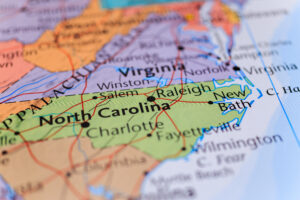Writer: Liz Palmer
 4 min read December 2022 — The spotlight on the Triangle continued to expand in 2022, and some of the fastest-growing counties, like Lee and Johnston, have been the primary beneficiaries of this growth. John Crumpton, county manager of Lee County and Chris Johnson, Johnston County’s Director of Economic Development, discussed with Invest: their plans for this ongoing growth, priorities to sustain it and more.
4 min read December 2022 — The spotlight on the Triangle continued to expand in 2022, and some of the fastest-growing counties, like Lee and Johnston, have been the primary beneficiaries of this growth. John Crumpton, county manager of Lee County and Chris Johnson, Johnston County’s Director of Economic Development, discussed with Invest: their plans for this ongoing growth, priorities to sustain it and more.
What initiatives for growth have been your priority?
John Crumpton: We have a lot going on. We haven’t had any new company announcements in the last few months but the companies that did announce are now almost finished with their buildings. They are operating and many of them are producing and delivering products. We are coming to the end of many of these projects and we are asking, “What’s next?” The city has done a lot of work in planning for water and sewer projects and improving new industrial sites. We have 1,000 acres of industrial property in Lee County.
Also, we finished renovating our government center, courthouse and parks in the last 12 months. The parks got a nice facelift and we are far along now in the design of a new 33,000-square-foot library that will double the current size. Hopefully, we will be out to bid in January for a new multisport complex with diamond and rectangle fields, as well as a destination playground.
We also purchased a facility for the community college and we transferred it to the college on Aug. 1. They are beginning to start the renovation, which is important because that facility will be the training ground for VinFast employees. It is a big, regional cooperation with Chatham County to help train those workers for the largest economic development project in the state. We had some issues there but this is the thing I am most proud of in the last 12 months because it didn’t seem like it could be done. We are busy trying to grow, as these achievements show.
 Chris Johnson: Growth is exciting, but it comes with challenges. With growth comes expectations of stakeholders; that means infrastructure, water and sewer, schools and other quality of life determinants – it’s overall meeting the needs of citizens. Johnston County has been very fortunate, and this has not been an overnight case. We have been growing for the past two decades. We passed multiple school bonds, which is where a lot of our investment has gone. Our facilities are second to none. Don’t get me wrong, we have pressure points, but we’re doing a great job. We’re growing by about one school per year. We accomplished new construction and updating existing facilities without affecting our property taxes.
Chris Johnson: Growth is exciting, but it comes with challenges. With growth comes expectations of stakeholders; that means infrastructure, water and sewer, schools and other quality of life determinants – it’s overall meeting the needs of citizens. Johnston County has been very fortunate, and this has not been an overnight case. We have been growing for the past two decades. We passed multiple school bonds, which is where a lot of our investment has gone. Our facilities are second to none. Don’t get me wrong, we have pressure points, but we’re doing a great job. We’re growing by about one school per year. We accomplished new construction and updating existing facilities without affecting our property taxes.
In terms of our transportation network directly into the county, we have I-95 along the corridor, I-40 running out of Raleigh and U.S. 70 being transitioned into I-42 to us. We’re one of the few counties in the state to have three interstates that touch our community, all of which point us to the Triangle. There are other transportation projects happening outside the county that will positively impact us.
It can be easy to think about economic development in the confines of a county, but the reality is that developments and expansions in Johnston County affect everyone around us, too. Our labor opportunities affect a 25-county region, so the developments and announcements being made here affect a quarter of the State of North Carolina. Johnston County is a vital part of the Raleigh MSA, we are the fastest growing county in North Carolina and that doesn’t seem to be slowing anytime soon. We’re starting to hold our own; we used to be the little brother of the Triangle’s urban core. Our population is around 235,000, and we could easily be over 300,000 in less than eight years. Our largest town is only about 25,000; 70% of our population doesn’t live in a municipality, and there are a lot of rural areas for people to call home here. We’re still committed to agriculture. With that rural component and our growing development combined, it’s almost like we’re two counties in one. Our economy is diverse, and we’re very strong. My role is related to bringing industry and jobs, but other cylinders have to be firing off to ensure the engine runs, and that includes small business support. My wife and I have been running a small business for 32 years, and whether you have $500,000 in sales per year or $500 million, the CFO is still spending 24 hours each day focused on keeping things running.
What is in store for the future of your county?
Crumpton: The county developed an alliance with the city of Sanford, the local chamber of commerce and the local economic development group to start a one-stop shop in the Buggy Factory. The developer wanted to sell the building but we bought it so we could keep these alliances together between the city, the county and Sanford. It has been successful at attracting industry and development in the county, so we wanted to continue that. We also have great partnerships with our K-12 system and the local colleges because education is a big piece of economic development, whether it is developing the workforce of the future or educating their children. We spend a lot of time on that. We are one of the first to have a program called the “College Promise Program,” which allows students to go to community college for free for two years. We have good relationships with Chatham and other surrounding counties. They need some of our infrastructure, so we work closely. We need good partners to execute our plans, so we always have great partners.
Johnson: When it comes to regional rail, the main focus is how it will be paid for. I’m personally a huge supporter of regional rail; a train runs both ways, and those living in Downtown Raleigh could commute to Johnston County for work if they wanted to. County commissioners have been studying it, but again, it all comes down to how it’ll be paid for. The jury’s still out, but it’s something we are monitoring and supporting. We are still trying to build up bus rapid transit (BRT). The challenge for public transit is that Johnston County is big but not dense; we have no large urban core that has traditionally shown success with regional rail. We also don’t have the large urban capacity people would drive to then catch a train for; that very well may change in the future. We’ve been part of the conversation, but we’ll see what things look like in a few years.
Coming out of the fog of COVID, everybody was concerned about what would come next. The U.S. had its pause, and now my office phone is ringing off the hook with inquiries. The reshoring of manufacturing in response to pressures on the supply chain and realizing we can’t be solely relying on resources from another country has brought a lot of interest and development to Johnston County. We see a concentrated effort of revisiting what can be done locally so the supply chain can’t be as easily disrupted. We are working on meeting the challenges of finding labor, and through that has come the automation of processes where there are pressure points. I have a few sites and pieces of land available, but there is so much demand for existing buildings that I hardly have any product. I have turned away 50 or 60 projects as of October because I don’t have any buildings. My role is figuring out how to solve that problem. We’ve begun public-private partnerships without competing with the private sector to ensure we are all successful.
What lingering challenges are you facing?
Crumpton: COVID has left some lingering effects that are not related to health. One is the work from home modality because we need more infrastructure in place for that. We have a broadband initiative with funding from the federal government and we want to expand that to all areas in the county. Connectivity and communication will be very important going forward. It is important for industry and individuals because more people are doing hybrid work. Then, we need amenities to attract people and we are working hard to make that happen. The city is connecting Sanford via rail with the S-Line project, for example. We want to get ahead on these things because although it may not be needed, as the highways get busier it will be necessary. We want to continue to think outside the box to make this a great place to work and play.
Johnson: I make the commissioners’ visions reality, so it really depends on what they envision growth looking like over the next few years, but as an advocate for Downtown, I remember a growth spurt of the county happening outside of municipalities, where more people were moving into the rural side of things. In the past three to five years, there has been a concerted effort to push that growth to the municipalities, because then they can begin to be intentional about putting together great amenities, as opposed to encouraging sprawl. I see that moving forward in the future.
We have a labor pool of about 110,000 people, but about 65% of our workforce leaves the county every day. My role is to turn those cars around, and I know many of them would much rather have a five minute commute to work than the 45 minutes they are currently doing. Through the JoCo Works program, we are exposing the opportunities our county has to offer our youth. It’s showing them that they can still get a postsecondary education if they choose to, and whatever they would like to study, we show them examples of career pipelines they can have in Johnston County.
For more information, visit:

